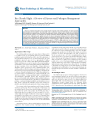

Subgroup AG1-1A is responsible for causing Sheath blight disease ( Yuan et al., 2018). The fungus is a soil borne necrotroph, divided into 14 anastomical groups (AG1 to AG13) based on the diversity in colony morphology, biochemical and molecular markers, pathogenicity, and aggressiveness. This disease is caused by a wide host range fungal pathogen, Rhizoctonia solani. It can cause up to 50 % of yield losses under optimal environmental conditions ( Qingzhong et al., 2001). Rice Sheath Blight (SB) disease is one among the top three most devastating diseases of rice worldwide. solani infection and provided a better understanding of rice plant response to R. Our integrative analysis identified 7 putative SB resistant genes altered in rice after R. Circadian clock was also strongly influenced by R. Involvement of MAPK, CYPs, Peroxidases and PAL genes was observed in response to the fungal infection. Jasmonic acid signaling pathway was activated and in contrast, photosynthesis and carbon fixation processes were significantly compromised. Regulatory network analysis identified SUB1B, MYB30 and CCA1 as important regulatory hub Transcription Factors in rice during R. Machine learning and network based integrative approach was used to construct Transcriptional Regulatory Networks (TRNs) of the rice plant at the three Time Points. GO and KEGG enrichment analysis identified significant processes and pathways differentially altered in the rice plant after the fungal infection. In total, 428, 32 genes were differentially expressed in the treated rice plants post 1, 2 and 5 dpi, respectively. solani infection at 1 st, 2 nd and 5 th day post inoculation (dpi). We have performed a Time-Series RNA-Seq analysis on a widely cultivated rice variety BPT-5204 for identifying its transcriptomic response signatures to R.


Naturally occurring rice varieties resistant to SB have not been reported yet. solani) is one of the severe rice diseases that can cause up to 50% yield losses. Sheath Blight (SB) disease in rice crop caused by the infection of the fungal pathogen Rhizoctonia solani ( R.


 0 kommentar(er)
0 kommentar(er)
